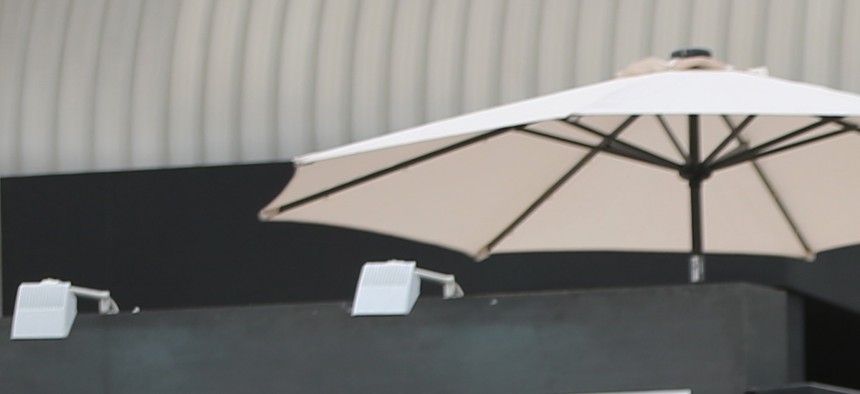
mirati officials visit the International Defence Exhibition and Conference, IDEX, in Abu Dhabi, United Arab Emirates, Sunday, Feb. 22, 2015. Kamran Jebreili/AP
The US and Russia Are the Biggest Beneficiaries of the Global Arms Boom
Emerging markets in Asia and the Middle East are splurging on weapons, and especially ones made by American and Russian companies.
One of the features of the 21st century, particularly since the 2008 financial crisis, has been the increasing number of rankings in which the United States is no longer number one. Title of top arms exporter, however, is not one of them—at least not yet—with the US maintaining its number one spot almost every year since the Cold War ended.
At February’s International Defense Exhibition in Abu Dhabi, around 1,200 companies from 56 countries showcased their hardware, trying to sell their high-resolution surveillance satellites, Reaper drones, and Kalashnikov rifles to the government officials and military brass in attendance. Plenty of American arms makers were on hand in hopes of maintaining their global dominance.
The US controlled 31% of the global market for weapons exports from 2010 to 2014, up from 29% from 2005 to 2009, according to the Stockholm International Peace Research Institute (SIPRI), the world’s best-known collector of defense spending and weapons trade statistics. Russia came a close second with 27%, a significant increase from 22% in the prior period, followed by China, Germany, and France each with a 5% share of the arms market.
The fast-rising wealth of emerging markets like India and countries in Africa that are gobbling up a growing share of weapons is rapidly changing the arms market, particularly as global instability seems to grow year after year. The surge in conflicts involving non-state actors in the Middle East and Africa is also forcing more countries to stock up, creating more demand for tanks, advanced weapons systems, and especially light arms.
And regional rivalries between India and its neighbors Pakistan and China, as well as Saudi Arabia and the Gulf states with Iran, continue to simmer. Government coffers, filled with earnings from oil, manufactured goods and other exports, can readily be tapped to purchase weapons from abroad, even if spending on education, health and infrastructure might provide greater long-term benefits. The USCongressional Research Service estimates that global arms transfers rose from about $51 billion in 2004 to $85 billion in 2011, totaling more than $500 billion over the eight-year period.
US corporate dominance
At the moment, the global defense industry remains an area of US corporate dominance. Six American companies placed among the top eight global firms, based on defense-related revenues. Lockheed Martin topped the list with $35 billion in arms sales, with Boeing in second place ($31 billion). Raytheon ($22 billion), Northrop Grumman ($20 billion), and General Dynamics ($19 billion) ranked fourth through sixth, while United Technologies ($12 billion) took eighth.
(Related: Inside the Glitz of a Middle East Arms Show)
Obviously, a large portion of the revenues generated by these firms comes from the US Department of Defense. But exports are essential, since it allows the companies to produce larger quantities of fighter planes, tanks, and other weapons systems, thereby driving down the per unit cost, which ultimately benefits the Pentagon and American taxpayers.
So while arms exports help achieve national security and foreign policy goals, they provide significant economic benefits as well, particularly for the workers and communities where production is located.
Who’s buying
Buyers in Asia and Oceania snared the most US weapons, or 48%, while recipients in the Middle East purchased 32%. Another 11% went to Europe. Meanwhile, Russia’s biggest buyers were India, China and Algeria, which consumed 60% of its arms exports. Overall, it sold arms to 56 countries and the rebels it backs in Ukraine, according to SIPRI.
One of the most interesting, and perhaps disturbing, global trends is the increased defense spending and weapons trade by emerging market economies. India was the largest importer of weapons from 2010 to 2014, accounting for 15% of all global arms imports, followed by Saudi Arabia, China, and the United Arab Emirates.
As countries in Asia and Africa get richer, larger sums are being spent on defense, particularly weapons imported from the world’s largest producers.
Africa, which has experienced some of the world’s most impressive economic growth over the past decade, saw arms imports increase 45% over the past five years. Part of this is due to windfall revenues earned by oil-producing countries, while inter-state rivalries between Algeria and Morocco and intra-state conflicts in Nigeria and Cameroon drive additional demand.
China, whose economy recently surpassed that of the US on a purchasing power parity basis, has moved into third place in weapons exports for the first time, signifying the country’s growing importance in international affairs. It also shows off China’s rapidly rising defense budget, which concerns many of its neighbors, as well as the US.
The illicit arms market
Traditionally, countries have been the primary buyers of armaments. However, the rise of non-state actors such as Al-Qaeda, Boko Haram, and ISIS has raised concerns about weapons falling into their hands. Organizations such as these rarely purchase weapons directly from the leading arms-exporting countries—certainly not planes, tanks, and heavy artillery.
Terrorist and guerrilla groups typically acquire weapons in two ways. The first is the illicit trade of small arms and light (man-portable) weapons such as assault rifles, grenades, mortars and land mines. Many of these weapons have been in circulation for decades, the result of US and Soviet support for their respective allies during the Cold War.
Such weapons are easily smuggled across borders today, facilitated by all of the financial, logistic and communication benefits that globalization provides to legitimate international commerce. When countries like Libya collapse into civil war, their supply of weapons is quickly acquired by factions within the country, or enters the illicit global arms market.
The second way that non-state organizations acquire weapons is from soldiers they defeated in battle, or military supplies from areas they conquered. So, for example, Boko Haram benefits from sympathizers in the Nigerian military who have facilitated the transfer of weapons to the terrorist group, as well as porous borders that make it easy to transport weapons from neighboring countries.
ISIS obtained many light weapons from the battlefield where it defeated Iraqi forces, and more sophisticated weapons when it overran Iraqi military bases. It is an unfortunate fact that far more people around the world, especially non-combatants, are killed by these light arms and weaponry than the far more expensive weapons systems associated with major defense contractors like Lockheed Martin or UK-based BAE Systems.
The post-9/11 arms world
In the post-9/11 world, military leaders are prioritizing command, control, communications, computers, intelligence, surveillance, and reconnaissance over more traditional weapons systems like aircraft, ships, and tanks. As a result, less well-known companies such as L-3 Communications, Exelis, and Leidos are quickly moving up the global rankings by producing high-tech avionics, drones, encryption devices, sensors, night vision goggles, and information technology services.
In response to cuts in US defense budgets in the years following the Iraq and Afghanistan draw-downs, most defense firms have diversified their sales to more non-defense applications, or to other countries by way of exports. These trends have made competition for Pentagon weapons contracts even more intense, since fewer and higher-priced items are being acquired.
But this appears to be shifting in light of heightened levels of global insecurity from the likes of terrorist groups, provocations by Russia, rivalries in Asia and nuclear ambitions in Iran and North Korea. In recent weeks, Congress has called for increases in defense spending. And other countries are using their growing economic power to build up their military power as well so they can better protect their interests and increase their regional and global influence.
At the end of the day, the main winners of global insecurity are likely to be defense companies.




